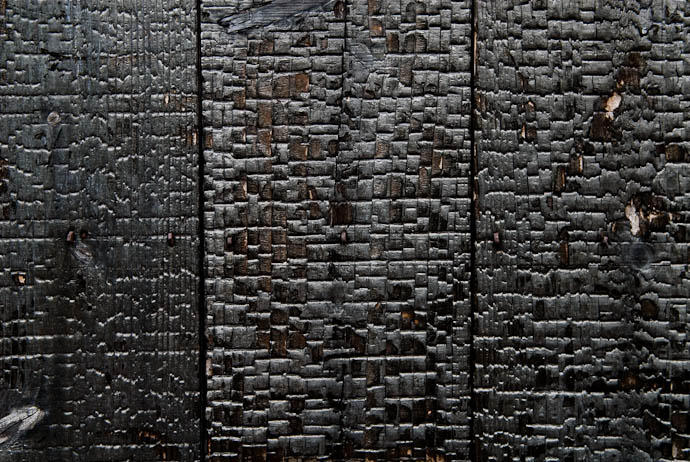
Nikon D200 + Nikkor 17-55mm f/2.8 @ 35 mm — 1/160 sec, f/5, ISO 320 — map & image data — nearby photos
Wall, Burnt to a Crisp
on purpose
The last time I posted a picture of a burnt wall, it was due to an unfortunate fire that destroyed a nearby restaurant. This time is a bit different.
The quietly famous Murin'an Garden (無鄰菴) near my house in Kyoto has outside walls that are quite varied and interesting. Some of them, such as those shown above, are wood whose top surface has been burnt to charcoal. Looking at a view showing the wall in situ you can see that the burning is clearly purposeful..
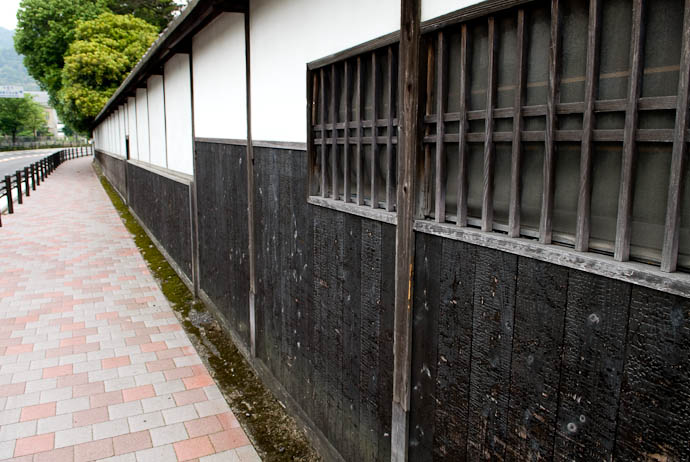
Nikon D200 + Nikkor 17-55mm f/2.8 @ 17 mm — 1/160 sec, f/5.6, ISO 320 — map & image data — nearby photos
North-Facing Wall of Murin'an
across the street from the Kyoto Zoo
While it's clear that the wood has been burnt intentionally, the reason is not clear. My first thought – and still my best guess – is that it was done to provide an inhospitable surface for wood-boring insects. If anyone actually knows, please leave a comment, because I'd love to know the actual reason.
Here's a closeup...
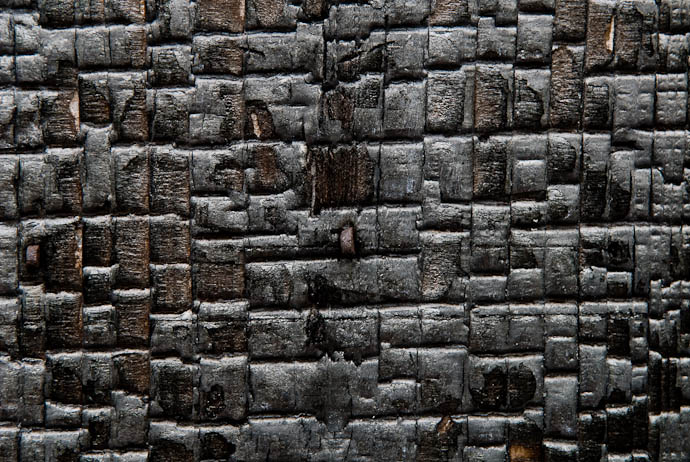
Nikon D200 + Nikkor 17-55mm f/2.8 @ 55 mm — 1/125 sec, f/5, ISO 320 — map & image data — nearby photos
Kyoto is filled with so much stuff that it's easy to pass by something every day and never notice it. I've been living a third of a mile from here for years and didn't notice the burnt nature of the wall until I happened to have while on a bike ride with Anthony this past June (the same outing that produced Life Stages of a Dandelion).
So, last week (five months later), I'm going by the same small gardens, this time passing their western wall just 20 meters from where I took the charcoal-wall shots, and notice that the wood is completely different...
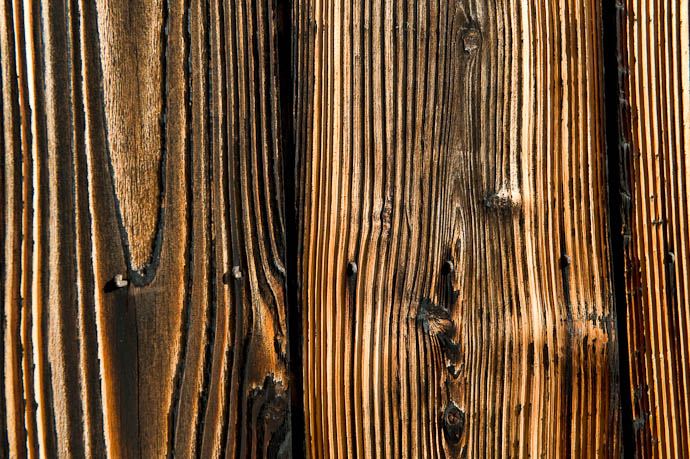
Nikon D700 + Nikkor 24-70mm f/2.8 @ 56 mm — 1/320 sec, f/7.1, ISO 200 — map & image data — nearby photos
Wood Grain in High Relief
I was walking with Paul Barr to the Nanzen Temple (some shots of which appeared in last week's Recovering Photos from a Corrupt Memory Card post) and had just showed him the charcoal wall when we noticed the completely different (and completely odd) western wall.
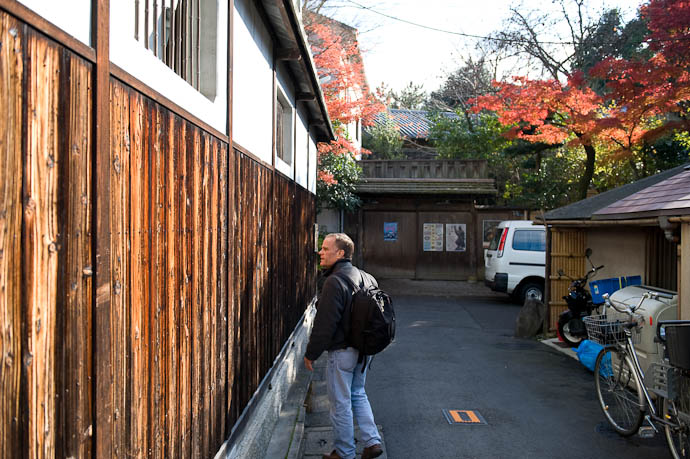
Nikon D700 + Nikkor 24-70mm f/2.8 @ 32 mm — 1/640 sec, f/3.5, ISO 200 — map & image data — nearby photos
Checking Out the Weird Wood
on the western wall of murin'an
I took a bazillion pictures trying to show the amazing relief – sometimes almost a quarter inch – that made the surface of the wood more like a cheese grater than a wall....
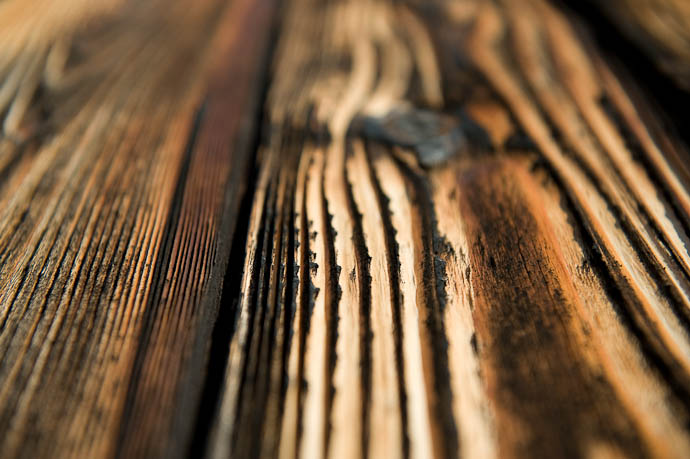
Nikon D700 + Nikkor 24-70mm f/2.8 @ 56 mm — 1/2000 sec, f/3.5, ISO 200 — map & image data — nearby photos
Fail
trying to show the relief
I finally hit on the idea of using a shadow, so threw up my arm to cast one, and achieved at least a level of success...

Nikon D700 + Nikkor 24-70mm f/2.8 @ 58 mm — 1/1000 sec, f/3.5, ISO 200 — map & image data — nearby photos
Relief
from the urge to try to show the wood's relief
You can also see that some parts are burnt, and that some burnt parts have clearly been shed, but also clear is that this is a completely different process than was done to the wood on the other wall.
The parts of the board sticking up are the knots and the wood's rings, so I'm guessing that the other softer parts of the wood were burnt more (and so more shed), or shrunk away over time, or.... er.... something. I dunno.
I think it's pretty, so here are two more views....
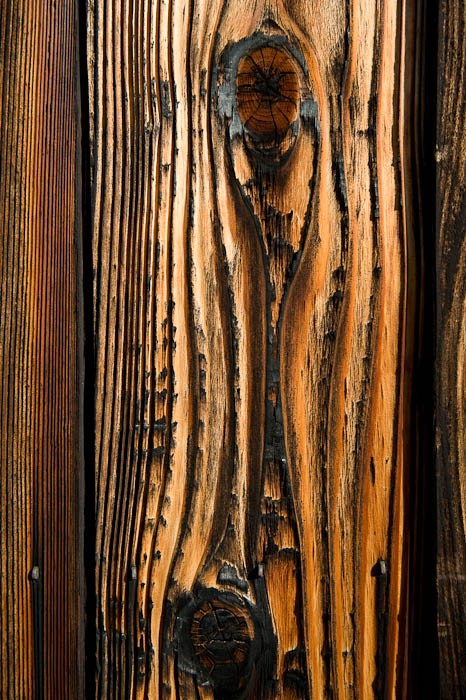
Nikon D700 + Nikkor 24-70mm f/2.8 @ 45 mm — 1/1600 sec, f/3.5, ISO 200 — map & image data — nearby photos
Knotty
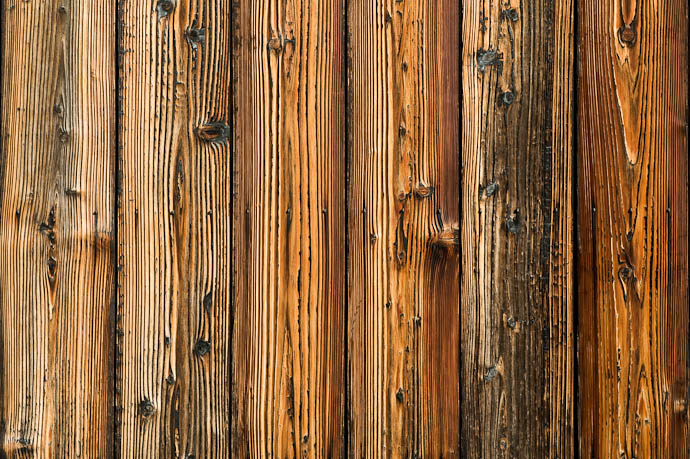
Nikon D700 + Nikkor 24-70mm f/2.8 @ 70 mm — 1/400 sec, f/7.1, ISO 200 — map & image data — nearby photos
The wall wraps around, and continues east toward Nanzenji. Through the magic of my Proximity-Search plugin for Lightroom, I found this shot showing the wall wrapping around, in the background....
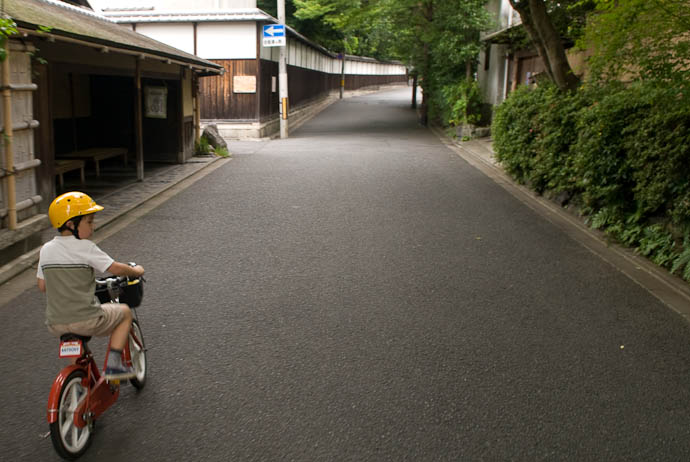
Nikon D200 + Nikkor 17-55mm f/2.8 @ 17 mm — 1/80 sec, f/5.6, ISO 320 — map & image data — nearby photos
Anthony Riding Toward Murin'an
The blue “one way” arrow points right at where Paul was standing in the shot above. Anyway, from inspecting the wear on the wall all the way along, and from noticing that there are occasionally sections of two or three slats that are of the charcoal variety, it's my guess that this “relief wood” is the original wall, and that the charcoal type is some later-date replacement / repair.
Murin'an (無鄰菴) is a small Japanese garden that dates from the late 1890s. It's small – less than an acre – surrounded by city, but well hidden. I lived nearby and passed by for years without even noticing it was there. But when you're inside, the city just melts away and you feel as if you're a million miles from civilization.
Here are a couple of shots from 2007 when I visited with some recently-married friends, Kuan Fu and Verena...
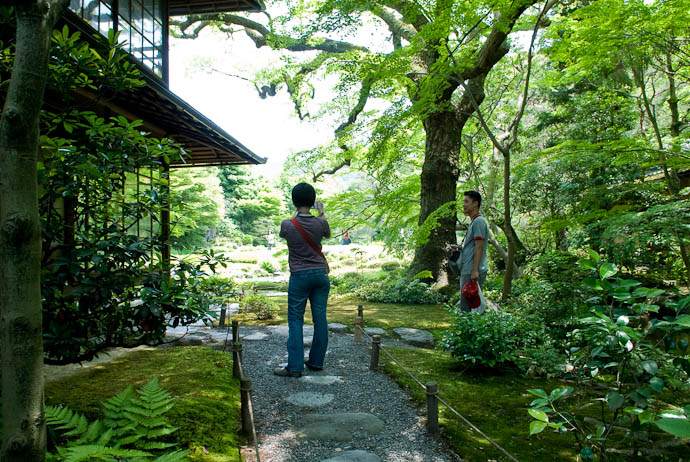
Nikon D200 + Nikkor 17-55mm f/2.8 @ 17 mm — 1/30 sec, f/7.1, ISO 160 — map & image data — nearby photos
Just Inside Murin'an
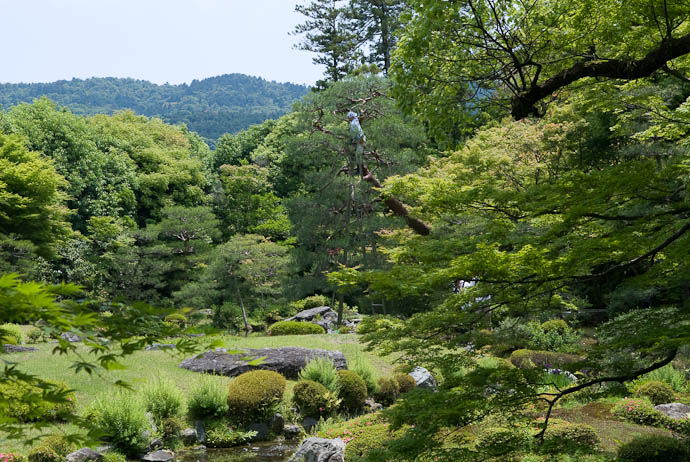
Nikon D200 + Nikkor 17-55mm f/2.8 @ 40 mm — 1/800 sec, f/7.1, ISO 400 — map & image data — nearby photos
Arborist At Work
Murin'an Garden, Kyoto Japan
More shots from that outing are on my KFC and Verena in Kyoto..
I don't know whether anyone will actually find them useful, but I've provided desktop-background versions of four of the shots above... see the links under their respective photos.
I think it is burned for the same reason the bottom 1/3 of fence posts were burned; so that that section wouldn’t get wood rot after being buried in the ground, from absorbing and then losing groundwater repeatedly. Your theory about insects is also probably right as well.
Japanese craftsmen have used a technique of burning wood to create a high reliefs – featuring highly figured wood grain.
This may explain some of the wood in the images.
With regard to the charcoal, the process my serve a function, but may also be ritual.
Insects (termites) will still dig to seek food, though this may lessen the damage, or be perceived to do so.
~V
Weatherproofing from before the days of paint.
I believe Verve is correct. This technique is accomplished by first scorching the area with a flame or a torch, then wire brushing (or some other stiff brush) the scorched part s away. This works well when the wood contains both hard and soft grain…the softer grain brushes away, leaving the harder grain in a higher relief. It can also be done o n older wood without the flame if the softer grain has begun to deteriorate.. I like the weathered effect it produces. But what a lot of effort went in to those walls!
The process is very similar here in Italy where time ago people burning the base of stackes for avoid degrading of the wood in the time. Anyway the effect is very beauty and I think to try to create in some my object in my home 🙂
regards
maz
Shou Sugi Ban is what it is called. No need for paint… protects the inside of the wood. Burning the cellulose makes the surface unedible to bugs. Its fun to do and begs experimwntation. Cool pics.
Thanks for the heads up on the name. It prompted some searching, where I found out it’s called 「焼杉板」in Japanese (焼杉 on Wikipedia), pronounced yakisugiban. The only reference to “Shou Sugi Ban” I could find in Japanese were Japanese natives asking other Japanese natives how/why 「焼杉板」seems to have become 「Shou Sugi Ban」in English. 🙂 —Jeffrey